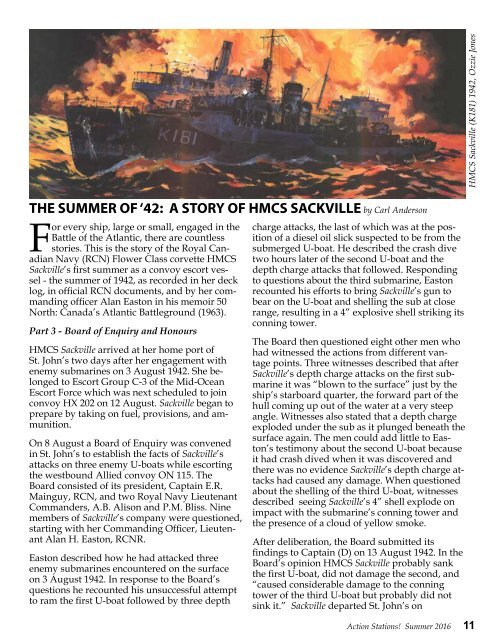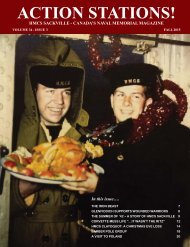ACTION STATIONS!
Action-Stations-Summer-email-and-web-issue-2016
Action-Stations-Summer-email-and-web-issue-2016
Create successful ePaper yourself
Turn your PDF publications into a flip-book with our unique Google optimized e-Paper software.
HMCS Sackville (K181) 1942, Ozzie Jones<br />
THE SUMMER OF ‘42: A STORY OF HMCS SACKVILLE by Carl Anderson<br />
For every ship, large or small, engaged in the<br />
Battle of the Atlantic, there are countless<br />
stories. This is the story of the Royal Canadian<br />
Navy (RCN) Flower Class corvette HMCS<br />
Sackville’s first summer as a convoy escort vessel<br />
- the summer of 1942, as recorded in her deck<br />
log, in official RCN documents, and by her commanding<br />
officer Alan Easton in his memoir 50<br />
North: Canada’s Atlantic Battleground (1963).<br />
Part 3 - Board of Enquiry and Honours<br />
HMCS Sackville arrived at her home port of<br />
St. John’s two days after her engagement with<br />
enemy submarines on 3 August 1942. She belonged<br />
to Escort Group C-3 of the Mid-Ocean<br />
Escort Force which was next scheduled to join<br />
convoy HX 202 on 12 August. Sackville began to<br />
prepare by taking on fuel, provisions, and ammunition.<br />
On 8 August a Board of Enquiry was convened<br />
in St. John’s to establish the facts of Sackville’s<br />
attacks on three enemy U-boats while escorting<br />
the westbound Allied convoy ON 115. The<br />
Board consisted of its president, Captain E.R.<br />
Mainguy, RCN, and two Royal Navy Lieutenant<br />
Commanders, A.B. Alison and P.M. Bliss. Nine<br />
members of Sackville’s company were questioned,<br />
starting with her Commanding Officer, Lieutenant<br />
Alan H. Easton, RCNR.<br />
Easton described how he had attacked three<br />
enemy submarines encountered on the surface<br />
on 3 August 1942. In response to the Board’s<br />
questions he recounted his unsuccessful attempt<br />
to ram the first U-boat followed by three depth<br />
charge attacks, the last of which was at the position<br />
of a diesel oil slick suspected to be from the<br />
submerged U-boat. He described the crash dive<br />
two hours later of the second U-boat and the<br />
depth charge attacks that followed. Responding<br />
to questions about the third submarine, Easton<br />
recounted his efforts to bring Sackville’s gun to<br />
bear on the U-boat and shelling the sub at close<br />
range, resulting in a 4” explosive shell striking its<br />
conning tower.<br />
The Board then questioned eight other men who<br />
had witnessed the actions from different vantage<br />
points. Three witnesses described that after<br />
Sackville’s depth charge attacks on the first submarine<br />
it was “blown to the surface” just by the<br />
ship’s starboard quarter, the forward part of the<br />
hull coming up out of the water at a very steep<br />
angle. Witnesses also stated that a depth charge<br />
exploded under the sub as it plunged beneath the<br />
surface again. The men could add little to Easton’s<br />
testimony about the second U-boat because<br />
it had crash dived when it was discovered and<br />
there was no evidence Sackville’s depth charge attacks<br />
had caused any damage. When questioned<br />
about the shelling of the third U-boat, witnesses<br />
described seeing Sackville’s 4” shell explode on<br />
impact with the submarine’s conning tower and<br />
the presence of a cloud of yellow smoke.<br />
After deliberation, the Board submitted its<br />
findings to Captain (D) on 13 August 1942. In the<br />
Board’s opinion HMCS Sackville probably sank<br />
the first U-boat, did not damage the second, and<br />
“caused considerable damage to the conning<br />
tower of the third U-boat but probably did not<br />
sink it.” Sackville departed St. John’s on<br />
Action Stations! Summer 2016 11



